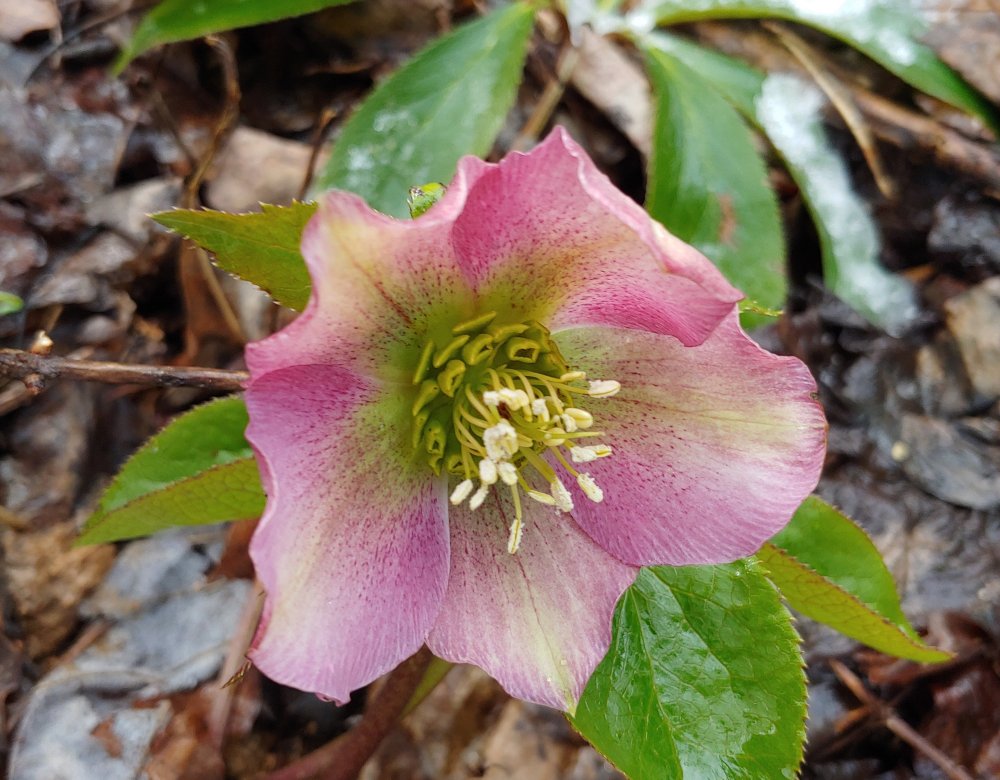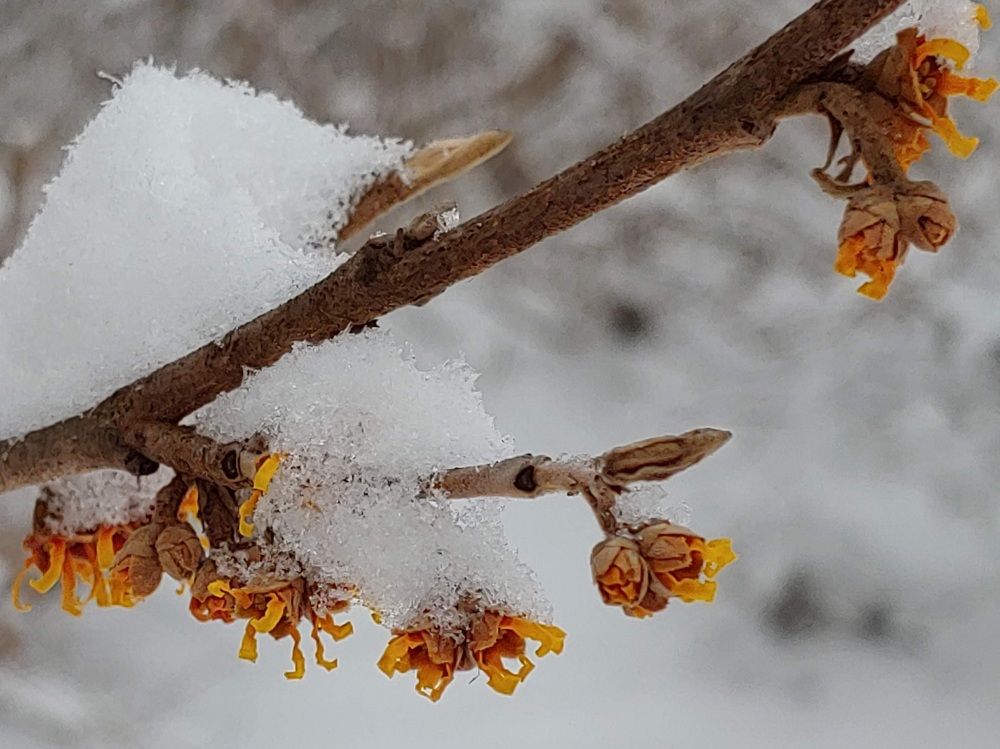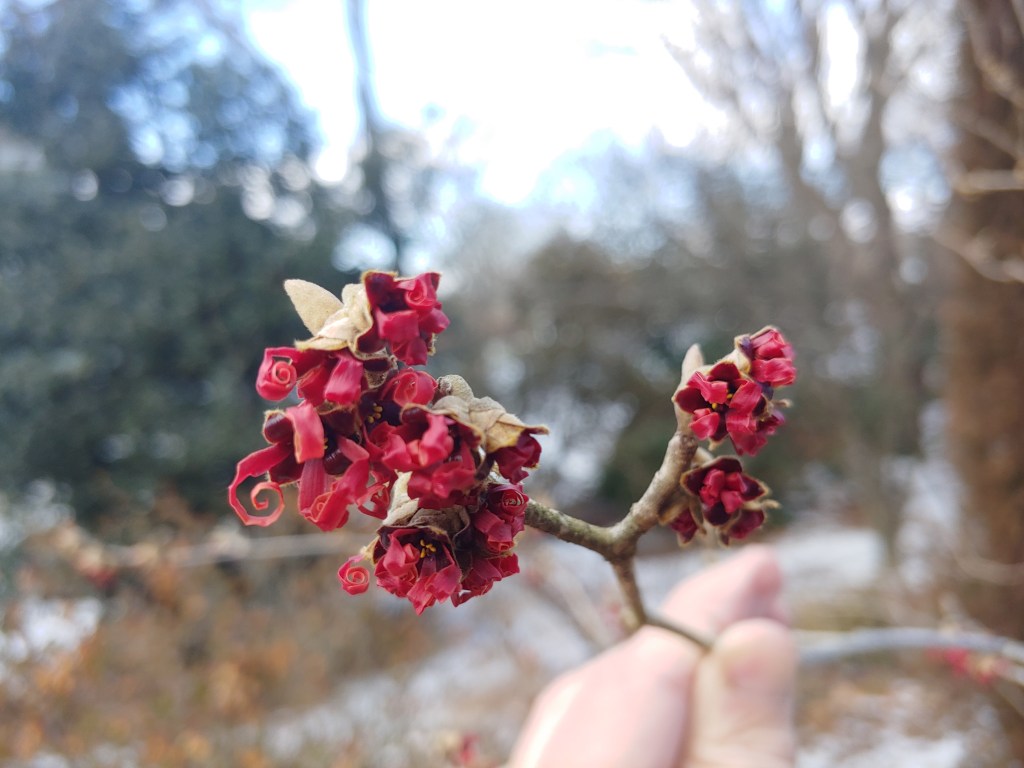With the mildest winter in memory a year ago, hellebores, snowdrops, and witch hazels reached peak bloom early in a glorious February. Winter aconites, crocus, sweetbox, and several pieris were colorful long before winter’s end. But not this year, despite a mild start with first blooms of hellebores and snowdrops before the new year.

Despite the tardiness of blooms, the gardener must not be distressed, though a bit of whining is permitted. While the garden must provide joy, it should also be considered one large science project, and the gardener must participate to try to figure why flowers don’t appear when expected, or why this part of the garden has become swampy when nothing seems to have caused the change. Perhaps there are no absolutes, but the gardener must be curious.

The gardener should notice that the small flowers of Vernal witch hazels (Hamamelis vernalis, above) curl tightly when temperatures fall into the mid-twenties, and that leaves of Anise shrubs (Illicium) hang limply until the thermometer rises to thirty degrees. I am hardly observant, only taking note of warm microclimates in the garden after three decades have passed, but when my patience is tested by witch hazels that are not flowering in the last week of February, I want to understand why.
Again this winter, temperatures will not drop below ten degrees (Fahrenheit). As best as I recall, several nights have dipped to seventeen degrees, and while daytime highs have continually fallen below averages, there have been no extreme periods of cold. Still I figure, it is not extreme cold that delays flowering, but consistent cold, and until this week temperatures have been chilly since sometime back in January. So, I’m not happy about it, but this explains the delayed flowering.

Today is fifty some degrees, and tomorrow sixty, so what happens now? I don’t have the answer, but I expect that buds will expand quickly. A witch hazel (Hamamelis x intermedia ‘Diane’, above) showing the slightest glimpse of color will be at peak bloom in a few days. Next week, the paperbushes (Edgeworthia chrysantha) that remains tight in bud will show the color expected in early February. And, while delayed flowers are gracing the garden, magnolias will bloom right on schedule, the complaining will be forgotten, and the gardener will be delighted.
I can always tell when it’s still bitter cold in the morning, because the leaves on my rhododendrons droop and curl. Where did you acquire your witch hazels? I am hoping to plant one someday in my own yard . . .
I’ve purchased Arnold Promise, Diane, Jelena, and vernal and common witch hazels from my local garden center, though only Arnold Promise seems to be regular inventory. I’ve purchased several out of the ordinary witch hazels by mail order, which is considerably more expensive for a much smaller plant, but offers more variety. For mail order I’ve purchased from Gossler Farms in Oregon since the ones they offer are one gallon and not smaller. Still, very small, and witch hazels are not real fast to get started.
Hellebores do not impress me. I probably mentioned that before. I used to grow them because our clients wanted them. I now work with a few within a landscape. They were there when I got there. Well, this year, they did not bloom much . . . until now. I don’t know what got into them, but they look great, and almost as impressive as they do in the pictures from other regions. Perhaps on Saturday, I will post some pictures. Except for burying them in compost earlier, we did nothing different for them. I should probably take better care of them in the future to see if they can do this again.
Sadly, I lost my one and only witch hazel two years ago after an extended drought which followed my moving it from one part of the garden to another. No matter how I watered and babied it, it seemed determine to wither. My winter mahonias, which are decades old, are thriving though and scenting the entire back yard. My hellebores are also thriving, including the fancy double white hybrid I planted a few years back and the pink and red ones I planted last year. Fingers crossed! I do love hellebores. They live up to their name of Lenten roses.
I lost a fifteen foot Arnold Promise several years ago when the surrounding soil became overly wet. I’ve added a few witch hazels since then, and I have a few more ordered for the next few weeks. Witch hazels are tough plants, but they do not like extremes in wet or dry soils. Unfortunately, my sense of smell is lacking in all but the strongest scents, so I can barely smell witch hazels, and I’ve never smelled anything from mahonias. This lacking was from long before covid.
What a shame! I get great pleasure from the scents of my garden and neighborhood. Mahonias were a surprise to me when we moved to the Southeast from the Northeast; I had never seen them before. I thought they were just big ugly weird-looking shrubs, until one winter day I smelled something lovely, followed my nose, and ended up at the big weird shrub with leathery leaves and now small yellow flowers. Now I appreciate their role in my garden, including their forms. A former owner who was an expert gardener planted them many years ago, a row of them behind a border of spring-blooming, small-leaved azaleas. They give great winter interest then provide a nice background for the pink azalea blossoms. You have to live with a garden for a long time to discover its secrets, if you weren’t the original gardener.